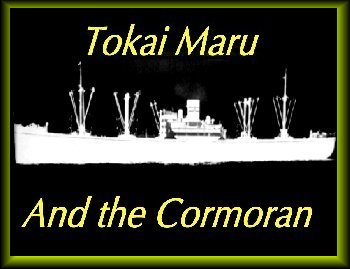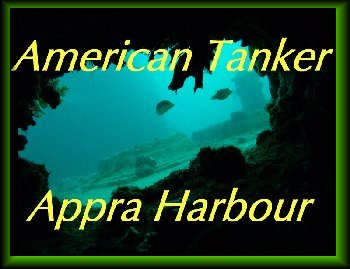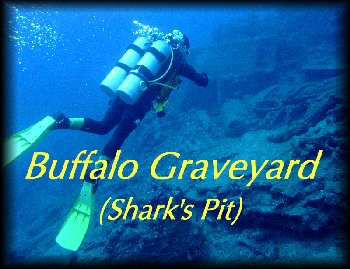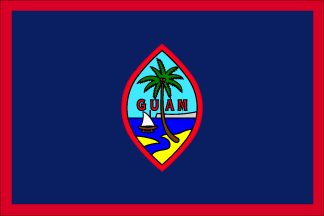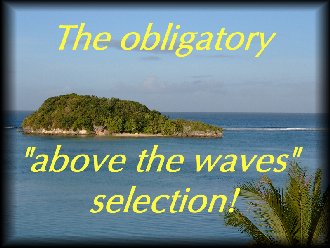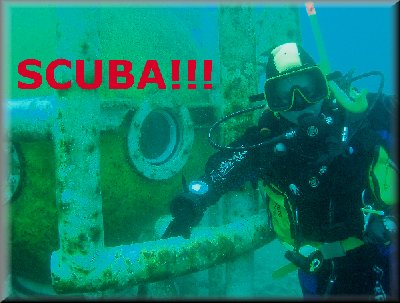|
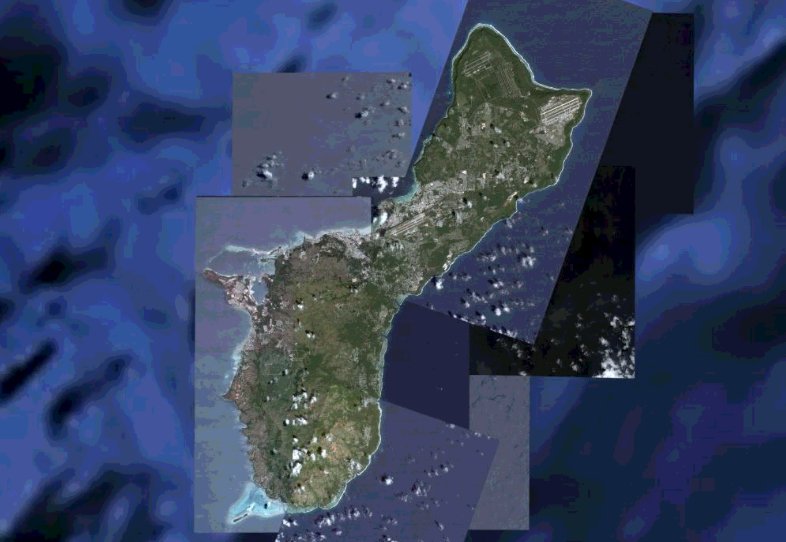 In January 2009 Tracy and
Martin visited the tiny Pacific island of Guam for the second time. We had stopped off there
very briefly in 2006 on the way to
Truk
Lagoon (Chuuk) and Bikini Atoll but had
never left the airport on that occasion. Following an article in Dive
magazine about the Cormoran and Tokai Maru wrecks we decided to visit in
conjunction with a third trip to the wrecks of
Coron Bay in the Philippines. In January 2009 Tracy and
Martin visited the tiny Pacific island of Guam for the second time. We had stopped off there
very briefly in 2006 on the way to
Truk
Lagoon (Chuuk) and Bikini Atoll but had
never left the airport on that occasion. Following an article in Dive
magazine about the Cormoran and Tokai Maru wrecks we decided to visit in
conjunction with a third trip to the wrecks of
Coron Bay in the Philippines.
Guam
is a very small island situated on the very edge of the deepest
underwater chasm in the world at 36,201 feet - the Marianas Trench. The
U.S. Navy bathyscaphe
Trieste reached the bottom at 13:06 on
January 23,
1960, with U.S. Navy Lieutenant
Don Walsh and
Jacques Piccard on board.
Guam was taken from the
indigenous Chamorro population by the Spanish in 1668, then was claimed by
the Americans along with Puerto Rico and the Philippines during the
Spanish - American war of 1898. The Japanese invaded the island in
December 1941 and fortified it heavily but it was finally recaptured in
1944 at great cost in lives to both sides. Following the Japanese
surrender Guam retained American administration and is today the home of
the largest American airbase in the Pacific.
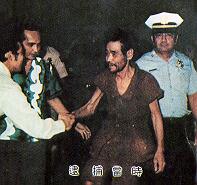 Some
might say however that the Japanese occupation of Guam did not actually
end in 1944 after all! On January 24th. 1972 Japanese army sergeant
Shoichi Yokoi was discovered by local Chamorran farmers living in an
extended cave system amongst bamboo groves deep in the Guam jungle. He had
single handedly "occupied" Guam for a further 28 years after the Japanese
surrender. He lived on snails, rats, eels, coconuts, breadfruit and
papayas for the duration and made his
own clothes from fibres taken from wild hibiscus plants. Upon his return
to Tokyo he made a statement that later became something of a popular
catch phrase throughout Japan... Some
might say however that the Japanese occupation of Guam did not actually
end in 1944 after all! On January 24th. 1972 Japanese army sergeant
Shoichi Yokoi was discovered by local Chamorran farmers living in an
extended cave system amongst bamboo groves deep in the Guam jungle. He had
single handedly "occupied" Guam for a further 28 years after the Japanese
surrender. He lived on snails, rats, eels, coconuts, breadfruit and
papayas for the duration and made his
own clothes from fibres taken from wild hibiscus plants. Upon his return
to Tokyo he made a statement that later became something of a popular
catch phrase throughout Japan...
"It is with much embarrassment
that I return"!!! We
flew out to Guam via Amsterdam, Hong Kong and Manila, arriving after a
stop over of a few days in Hong Kong to take in the sites of that amazing
city. Our intention was to complete 5 days diving on Guam before moving
back to Manila and down to Busuanga to dive the magnificent Japanese wrecks
from World War II in Coron Bay.
Diving Guam...
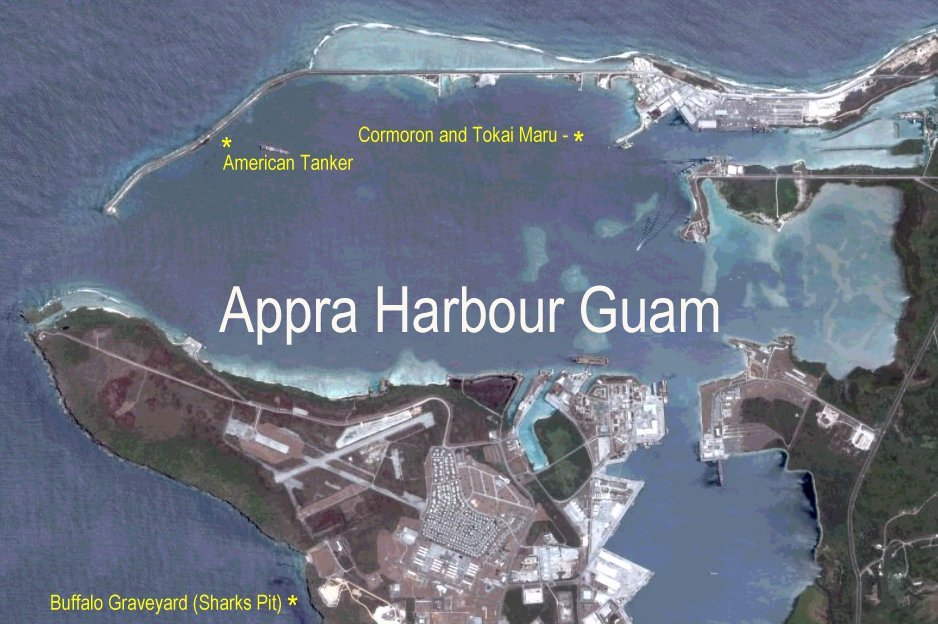
The SMS Cormoran II...
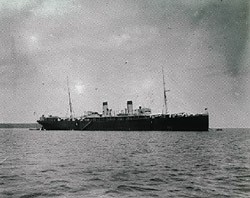 In
1909 a small passenger and cargo ship was built in a German shipyard at
Danzig (now Gdansk in Poland) for the Russian merchant fleet. She was
named the SS Ryaezan. At
the start of the Great War of 1914-18 she was captured by the German light
cruiser SMS Emden whilst operating off Korea and turned into an auxiliary
cruiser in a Chinese dockyard at Tsingtao by the fitting of armour and
armaments. Her new roll as a commerce raider was to attack allied shipping
operating in the Pacific. She was none to successful, largely due to the
actions of the British Navy, and on the 14th. December 1914 she finally
ran into Appra Harbour in Guam with less than 50 tons of coal remaining in
her bunkers. Due to the strained diplomatic relations between the American
and German governments the American
military governor of Guam would not allow the sale of coal to refuel the
ship and so she effectively began a period of internment. In
1909 a small passenger and cargo ship was built in a German shipyard at
Danzig (now Gdansk in Poland) for the Russian merchant fleet. She was
named the SS Ryaezan. At
the start of the Great War of 1914-18 she was captured by the German light
cruiser SMS Emden whilst operating off Korea and turned into an auxiliary
cruiser in a Chinese dockyard at Tsingtao by the fitting of armour and
armaments. Her new roll as a commerce raider was to attack allied shipping
operating in the Pacific. She was none to successful, largely due to the
actions of the British Navy, and on the 14th. December 1914 she finally
ran into Appra Harbour in Guam with less than 50 tons of coal remaining in
her bunkers. Due to the strained diplomatic relations between the American
and German governments the American
military governor of Guam would not allow the sale of coal to refuel the
ship and so she effectively began a period of internment.
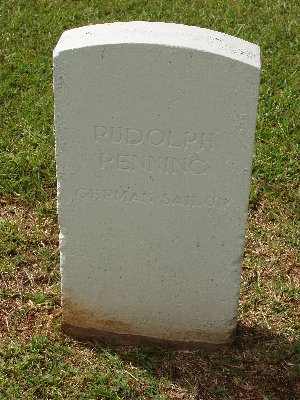 After some short
time the crew of 320 men left the ship to live ashore amongst the local
people, reportedly quite amicably. The United States of America had
remained neutral throughout the early years of the war but following
the torpedoing of the Cunard liner Lusitania off Ireland in 1916 with
tremendous loss of life including many American citizens bound for
England, the American president Woodrow Wilson declared war on Germany.
The captain of the Cormoran,
Korvettenkapitän Adalbert
Zuckschwerdt, (shown below left) After some short
time the crew of 320 men left the ship to live ashore amongst the local
people, reportedly quite amicably. The United States of America had
remained neutral throughout the early years of the war but following
the torpedoing of the Cunard liner Lusitania off Ireland in 1916 with
tremendous loss of life including many American citizens bound for
England, the American president Woodrow Wilson declared war on Germany.
The captain of the Cormoran,
Korvettenkapitän Adalbert
Zuckschwerdt, (shown below left)
 was faced with a dilemma now as he did
not wish to see his ship captured by the American navy so he ordered the
scuttling of his ship. Unfortunately for him everything did not go to plan
and the US Navy became aware of his intentions and attacked the Cormoran,
firing what were the first shots of the United States military forces
against the Germans in the Great War. During the engagement nine German
sailors were killed and they are buried today alongside American soldiers
and sailors who were killed in various conflicts ranging from the Spanish
- American war through the Great War to the Korean war in the 1950s. The
wreck lies now within Appra Harbour on her side in 30 some metres of
water. Sadly the visibility is not great but she is a superb dive, the
highlights for us being the bathroom and the engine room. was faced with a dilemma now as he did
not wish to see his ship captured by the American navy so he ordered the
scuttling of his ship. Unfortunately for him everything did not go to plan
and the US Navy became aware of his intentions and attacked the Cormoran,
firing what were the first shots of the United States military forces
against the Germans in the Great War. During the engagement nine German
sailors were killed and they are buried today alongside American soldiers
and sailors who were killed in various conflicts ranging from the Spanish
- American war through the Great War to the Korean war in the 1950s. The
wreck lies now within Appra Harbour on her side in 30 some metres of
water. Sadly the visibility is not great but she is a superb dive, the
highlights for us being the bathroom and the engine room.
The Tokai Maru...
From 1941 the Japanese navy operated out of Appra Harbour. A small freighter of
similar size to the
Morizan Maru (formerly known as the Olympia Maru)
was moored there. On January 24, 1943 the US submarine Flying Fish fired
two torpedoes at the Tokai. One ran aground almost immediately on the reef
but the second hit her.
But she failed
to sink...
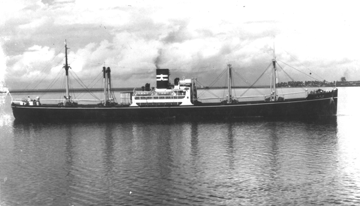 |
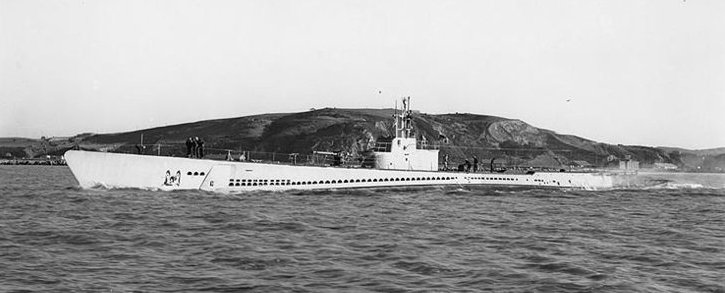 |
|
The Japanese freighter
Tokai Maru... |
The United States submarine
Snapper... |
Seven months later on at 15:23 on August 27th.
the US submarine Snapper had a second go at sinking the Tokai. Her captain
fired three torpedoes at her and finally she sank after some hours coming
to rest almost touching the Cormoran. In fact she is so close that it is
possible to put your hands on the Tokai and your feet on the Cormoran!
Now just
where else in the world can you do that???
The "American Tanker"...
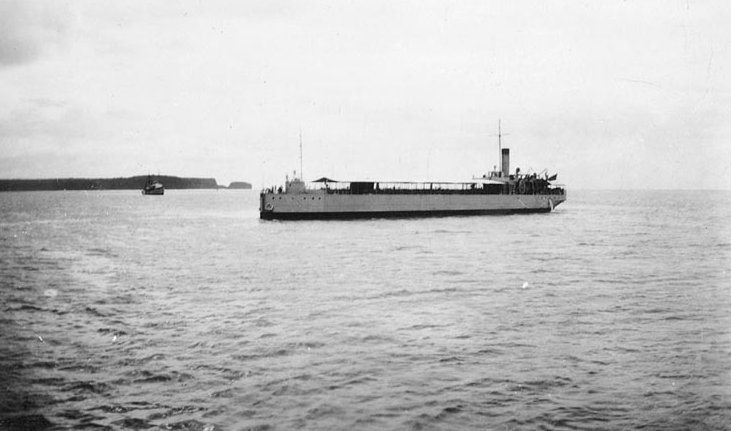 In
order to re-supply the extensive chain of Pacific islands as they were
progressively re-captured from the Japanese the US Navy needed large
utility ships in great numbers. A scheme was devised whereby huge barges
would be constructed from concrete and, lacking engines of there own, they
would be towed across the Pacific by tugs to their respective
destinations. One such ship was later scuttled in Appra Harbour to serve
as a temporary breakwater before the building of a more permanent
structure by US Navy Seabees (marine engineers) after the war had
finished. Despite the name of "American tanker" this ship was anything
but! And it is also difficult to see any evidence of her construction
involving concrete. We came to the conclusion that the concrete must have
been poured between two metal skins in order to provide extra strength.
She sits now in a shade over 30 metres only a few yards from the real
breakwater she was sunk to provide ahead of it's eventual construction and
several species of fish from the reef which has grown up on the blocks of
the breakwater have migrated across to colonise her decks and
superstructure. The viz on this wreck is much better than the inferior viz
on the Cormoran/Tokai site and there are numerous penetration
possibilities including cargo holds and the bridge area. In
order to re-supply the extensive chain of Pacific islands as they were
progressively re-captured from the Japanese the US Navy needed large
utility ships in great numbers. A scheme was devised whereby huge barges
would be constructed from concrete and, lacking engines of there own, they
would be towed across the Pacific by tugs to their respective
destinations. One such ship was later scuttled in Appra Harbour to serve
as a temporary breakwater before the building of a more permanent
structure by US Navy Seabees (marine engineers) after the war had
finished. Despite the name of "American tanker" this ship was anything
but! And it is also difficult to see any evidence of her construction
involving concrete. We came to the conclusion that the concrete must have
been poured between two metal skins in order to provide extra strength.
She sits now in a shade over 30 metres only a few yards from the real
breakwater she was sunk to provide ahead of it's eventual construction and
several species of fish from the reef which has grown up on the blocks of
the breakwater have migrated across to colonise her decks and
superstructure. The viz on this wreck is much better than the inferior viz
on the Cormoran/Tokai site and there are numerous penetration
possibilities including cargo holds and the bridge area.
The "Buffalo Graveyard" (Shark's Pit)...
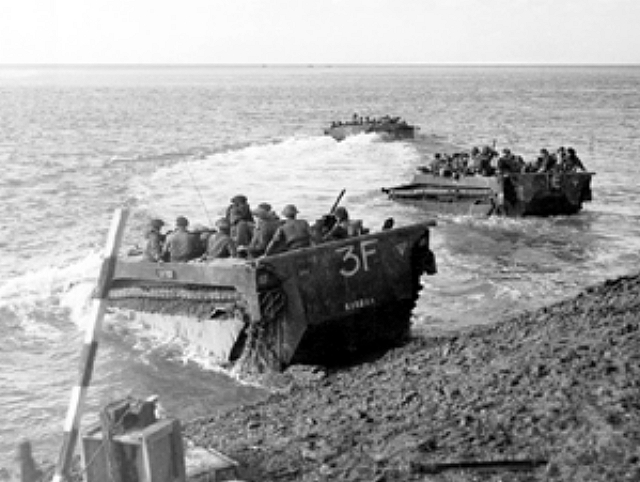 Beyond
the harbour entrance and around to the south rises a long cliff which runs
for some miles. Atop the cliff is an army firing range. If any of you can
remember what it was like to dive the S.S. Kyle Prince off Anglesey in the
1980's you'll know how weird it is to sit under a firing range during live
firing! Part of the cliff wall fell off many years ago and sits now in the
form of an enormous boulder on the seabed at the foot of the cliff, and we
anchored up on the boulder. Scattered all over the seabed at it's base is
a mass of military equipment bulldozed in from the top of the cliff after
the war had ended. The "official" name of this dive site is "Shark's Pit"
however for reasons which should become abundantly clear we renamed it
"The Buffalo Graveyard" after our first dive there. We dropped down to the
seabed in superb visibility of at least 35 metres and found hardware
scattered around as far as the eye could see. We swam across to the
upturned hull of a tracked vehicle which I immediately concluded was a
Sherman tank however something was not quite right with my diagnosis.
After some in depth consideration (literally in depth as we were at 36
metres by now!) the penny finally dropped! It was a Buffalo amphibious
landing vehicle and I had made an Airfix construction model of one some 37
years before! As the dive progressed we found more and more of these
distinctive vehicles along with drive engine units complete with their
sprockets and masses of concreted tracks. There were two with small
calibre field gins mounted in the rear troop carrying area, presumably to
act as support artillery immediately upon landing. This dive soon became a
"pointy-fest" and I struggled to stop my mask flooding with the
ever widening grin that spread across my face! Beyond
the harbour entrance and around to the south rises a long cliff which runs
for some miles. Atop the cliff is an army firing range. If any of you can
remember what it was like to dive the S.S. Kyle Prince off Anglesey in the
1980's you'll know how weird it is to sit under a firing range during live
firing! Part of the cliff wall fell off many years ago and sits now in the
form of an enormous boulder on the seabed at the foot of the cliff, and we
anchored up on the boulder. Scattered all over the seabed at it's base is
a mass of military equipment bulldozed in from the top of the cliff after
the war had ended. The "official" name of this dive site is "Shark's Pit"
however for reasons which should become abundantly clear we renamed it
"The Buffalo Graveyard" after our first dive there. We dropped down to the
seabed in superb visibility of at least 35 metres and found hardware
scattered around as far as the eye could see. We swam across to the
upturned hull of a tracked vehicle which I immediately concluded was a
Sherman tank however something was not quite right with my diagnosis.
After some in depth consideration (literally in depth as we were at 36
metres by now!) the penny finally dropped! It was a Buffalo amphibious
landing vehicle and I had made an Airfix construction model of one some 37
years before! As the dive progressed we found more and more of these
distinctive vehicles along with drive engine units complete with their
sprockets and masses of concreted tracks. There were two with small
calibre field gins mounted in the rear troop carrying area, presumably to
act as support artillery immediately upon landing. This dive soon became a
"pointy-fest" and I struggled to stop my mask flooding with the
ever widening grin that spread across my face!
So Guam...
is it a dive destination we would recommend?
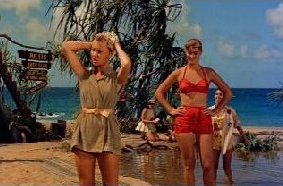 Well... to
be perfectly honest it's not your "South Pacific" island paradise lovingly
recreated in the Hollywood musical featuring the lovely Mitzi Gaynor...
*sigh... Well... to
be perfectly honest it's not your "South Pacific" island paradise lovingly
recreated in the Hollywood musical featuring the lovely Mitzi Gaynor...
*sigh...
It's
more like small town America with coconuts. There are far too many huge
gas guzzling cars speeding up and down the main six lane highway; too many
fast food outlets selling burgers the size of an English dinner plate; too
many big fat bellies atop way too loud American voices. Don't get me
wrong, they are not all stereotypical "septics" in Guam and many of the
people we met were very, very friendly. But you don't need too many bad
apples before it starts to get a tad overpowering. And that friendliness
could be fairly said to be good just so long as we still owed money. Our
dive shop GTDS simply could NOT be bothered to lift a finger to help us
out when we had cause to request a small favour from our next destination
- but of course by then we had already paid up in excess of $3000... note
- "already paid up"!
Perhaps you
should avoid GTDS...
And the
diving? Well it's somewhat limited. And although the dive shops don't
quite run to the more usual PADI "two tank" dive day we had experienced
elsewhere in American influenced areas where you do one dive then are
thrown back in 30 minutes later to do your second in 9 metres of water, it
was still a case of renting a boat for four hours and attempting to cram
in two decent dives plus a surface interval or end up paying $OMG per hour
for any time we might over run.
In short
then, if you are en-route to say Truk Lagoon then you might consider
breaking your trip for a day or so to avoid arriving b*ll*xed. And if you
are going to do that then perhaps Guam is worth a day or two...
|

 Some
might say however that the Japanese occupation of Guam did not actually
end in 1944 after all! On January 24th. 1972 Japanese army sergeant
Shoichi Yokoi was discovered by local Chamorran farmers living in an
extended cave system amongst bamboo groves deep in the Guam jungle. He had
single handedly "occupied" Guam for a further 28 years after the Japanese
surrender. He lived on snails, rats, eels, coconuts, breadfruit and
papayas for the duration and made his
own clothes from fibres taken from wild hibiscus plants. Upon his return
to Tokyo he made a statement that later became something of a popular
catch phrase throughout Japan...
Some
might say however that the Japanese occupation of Guam did not actually
end in 1944 after all! On January 24th. 1972 Japanese army sergeant
Shoichi Yokoi was discovered by local Chamorran farmers living in an
extended cave system amongst bamboo groves deep in the Guam jungle. He had
single handedly "occupied" Guam for a further 28 years after the Japanese
surrender. He lived on snails, rats, eels, coconuts, breadfruit and
papayas for the duration and made his
own clothes from fibres taken from wild hibiscus plants. Upon his return
to Tokyo he made a statement that later became something of a popular
catch phrase throughout Japan...

 In
1909 a small passenger and cargo ship was built in a German shipyard at
Danzig (now Gdansk in Poland) for the Russian merchant fleet. She was
named the SS Ryaezan. At
the start of the Great War of 1914-18 she was captured by the German light
cruiser SMS Emden whilst operating off Korea and turned into an auxiliary
cruiser in a Chinese dockyard at Tsingtao by the fitting of armour and
armaments. Her new roll as a commerce raider was to attack allied shipping
operating in the Pacific. She was none to successful, largely due to the
actions of the British Navy, and on the 14th. December 1914 she finally
ran into Appra Harbour in Guam with less than 50 tons of coal remaining in
her bunkers. Due to the strained diplomatic relations between the American
and German governments the American
military governor of Guam would not allow the sale of coal to refuel the
ship and so she effectively began a period of internment.
In
1909 a small passenger and cargo ship was built in a German shipyard at
Danzig (now Gdansk in Poland) for the Russian merchant fleet. She was
named the SS Ryaezan. At
the start of the Great War of 1914-18 she was captured by the German light
cruiser SMS Emden whilst operating off Korea and turned into an auxiliary
cruiser in a Chinese dockyard at Tsingtao by the fitting of armour and
armaments. Her new roll as a commerce raider was to attack allied shipping
operating in the Pacific. She was none to successful, largely due to the
actions of the British Navy, and on the 14th. December 1914 she finally
ran into Appra Harbour in Guam with less than 50 tons of coal remaining in
her bunkers. Due to the strained diplomatic relations between the American
and German governments the American
military governor of Guam would not allow the sale of coal to refuel the
ship and so she effectively began a period of internment.
 After some short
time the crew of 320 men left the ship to live ashore amongst the local
people, reportedly quite amicably. The United States of America had
remained neutral throughout the early years of the war but following
the torpedoing of the Cunard liner Lusitania off Ireland in 1916 with
tremendous loss of life including many American citizens bound for
England, the American president Woodrow Wilson declared war on Germany.
The captain of the Cormoran,
After some short
time the crew of 320 men left the ship to live ashore amongst the local
people, reportedly quite amicably. The United States of America had
remained neutral throughout the early years of the war but following
the torpedoing of the Cunard liner Lusitania off Ireland in 1916 with
tremendous loss of life including many American citizens bound for
England, the American president Woodrow Wilson declared war on Germany.
The captain of the Cormoran,
 was faced with a dilemma now as he did
not wish to see his ship captured by the American navy so he ordered the
scuttling of his ship. Unfortunately for him everything did not go to plan
and the US Navy became aware of his intentions and attacked the Cormoran,
firing what were the first shots of the United States military forces
against the Germans in the Great War. During the engagement nine German
sailors were killed and they are buried today alongside American soldiers
and sailors who were killed in various conflicts ranging from the Spanish
- American war through the Great War to the Korean war in the 1950s. The
wreck lies now within Appra Harbour on her side in 30 some metres of
water. Sadly the visibility is not great but she is a superb dive, the
highlights for us being the bathroom and the engine room.
was faced with a dilemma now as he did
not wish to see his ship captured by the American navy so he ordered the
scuttling of his ship. Unfortunately for him everything did not go to plan
and the US Navy became aware of his intentions and attacked the Cormoran,
firing what were the first shots of the United States military forces
against the Germans in the Great War. During the engagement nine German
sailors were killed and they are buried today alongside American soldiers
and sailors who were killed in various conflicts ranging from the Spanish
- American war through the Great War to the Korean war in the 1950s. The
wreck lies now within Appra Harbour on her side in 30 some metres of
water. Sadly the visibility is not great but she is a superb dive, the
highlights for us being the bathroom and the engine room.

 In
order to re-supply the extensive chain of Pacific islands as they were
progressively re-captured from the Japanese the US Navy needed large
utility ships in great numbers. A scheme was devised whereby huge barges
would be constructed from concrete and, lacking engines of there own, they
would be towed across the Pacific by tugs to their respective
destinations. One such ship was later scuttled in Appra Harbour to serve
as a temporary breakwater before the building of a more permanent
structure by US Navy Seabees (marine engineers) after the war had
finished. Despite the name of "American tanker" this ship was anything
but! And it is also difficult to see any evidence of her construction
involving concrete. We came to the conclusion that the concrete must have
been poured between two metal skins in order to provide extra strength.
She sits now in a shade over 30 metres only a few yards from the real
breakwater she was sunk to provide ahead of it's eventual construction and
several species of fish from the reef which has grown up on the blocks of
the breakwater have migrated across to colonise her decks and
superstructure. The viz on this wreck is much better than the inferior viz
on the Cormoran/Tokai site and there are numerous penetration
possibilities including cargo holds and the bridge area.
In
order to re-supply the extensive chain of Pacific islands as they were
progressively re-captured from the Japanese the US Navy needed large
utility ships in great numbers. A scheme was devised whereby huge barges
would be constructed from concrete and, lacking engines of there own, they
would be towed across the Pacific by tugs to their respective
destinations. One such ship was later scuttled in Appra Harbour to serve
as a temporary breakwater before the building of a more permanent
structure by US Navy Seabees (marine engineers) after the war had
finished. Despite the name of "American tanker" this ship was anything
but! And it is also difficult to see any evidence of her construction
involving concrete. We came to the conclusion that the concrete must have
been poured between two metal skins in order to provide extra strength.
She sits now in a shade over 30 metres only a few yards from the real
breakwater she was sunk to provide ahead of it's eventual construction and
several species of fish from the reef which has grown up on the blocks of
the breakwater have migrated across to colonise her decks and
superstructure. The viz on this wreck is much better than the inferior viz
on the Cormoran/Tokai site and there are numerous penetration
possibilities including cargo holds and the bridge area. Beyond
the harbour entrance and around to the south rises a long cliff which runs
for some miles. Atop the cliff is an army firing range. If any of you can
remember what it was like to dive the S.S. Kyle Prince off Anglesey in the
1980's you'll know how weird it is to sit under a firing range during live
firing! Part of the cliff wall fell off many years ago and sits now in the
form of an enormous boulder on the seabed at the foot of the cliff, and we
anchored up on the boulder. Scattered all over the seabed at it's base is
a mass of military equipment bulldozed in from the top of the cliff after
the war had ended. The "official" name of this dive site is "Shark's Pit"
however for reasons which should become abundantly clear we renamed it
"The Buffalo Graveyard" after our first dive there. We dropped down to the
seabed in superb visibility of at least 35 metres and found hardware
scattered around as far as the eye could see. We swam across to the
upturned hull of a tracked vehicle which I immediately concluded was a
Sherman tank however something was not quite right with my diagnosis.
After some in depth consideration (literally in depth as we were at 36
metres by now!) the penny finally dropped! It was a Buffalo amphibious
landing vehicle and I had made an Airfix construction model of one some 37
years before! As the dive progressed we found more and more of these
distinctive vehicles along with drive engine units complete with their
sprockets and masses of concreted tracks. There were two with small
calibre field gins mounted in the rear troop carrying area, presumably to
act as support artillery immediately upon landing. This dive soon became a
"pointy-fest" and I struggled to stop my mask flooding with the
ever widening grin that spread across my face!
Beyond
the harbour entrance and around to the south rises a long cliff which runs
for some miles. Atop the cliff is an army firing range. If any of you can
remember what it was like to dive the S.S. Kyle Prince off Anglesey in the
1980's you'll know how weird it is to sit under a firing range during live
firing! Part of the cliff wall fell off many years ago and sits now in the
form of an enormous boulder on the seabed at the foot of the cliff, and we
anchored up on the boulder. Scattered all over the seabed at it's base is
a mass of military equipment bulldozed in from the top of the cliff after
the war had ended. The "official" name of this dive site is "Shark's Pit"
however for reasons which should become abundantly clear we renamed it
"The Buffalo Graveyard" after our first dive there. We dropped down to the
seabed in superb visibility of at least 35 metres and found hardware
scattered around as far as the eye could see. We swam across to the
upturned hull of a tracked vehicle which I immediately concluded was a
Sherman tank however something was not quite right with my diagnosis.
After some in depth consideration (literally in depth as we were at 36
metres by now!) the penny finally dropped! It was a Buffalo amphibious
landing vehicle and I had made an Airfix construction model of one some 37
years before! As the dive progressed we found more and more of these
distinctive vehicles along with drive engine units complete with their
sprockets and masses of concreted tracks. There were two with small
calibre field gins mounted in the rear troop carrying area, presumably to
act as support artillery immediately upon landing. This dive soon became a
"pointy-fest" and I struggled to stop my mask flooding with the
ever widening grin that spread across my face! Well... to
be perfectly honest it's not your "South Pacific" island paradise lovingly
recreated in the Hollywood musical featuring the lovely Mitzi Gaynor...
*sigh...
Well... to
be perfectly honest it's not your "South Pacific" island paradise lovingly
recreated in the Hollywood musical featuring the lovely Mitzi Gaynor...
*sigh... 